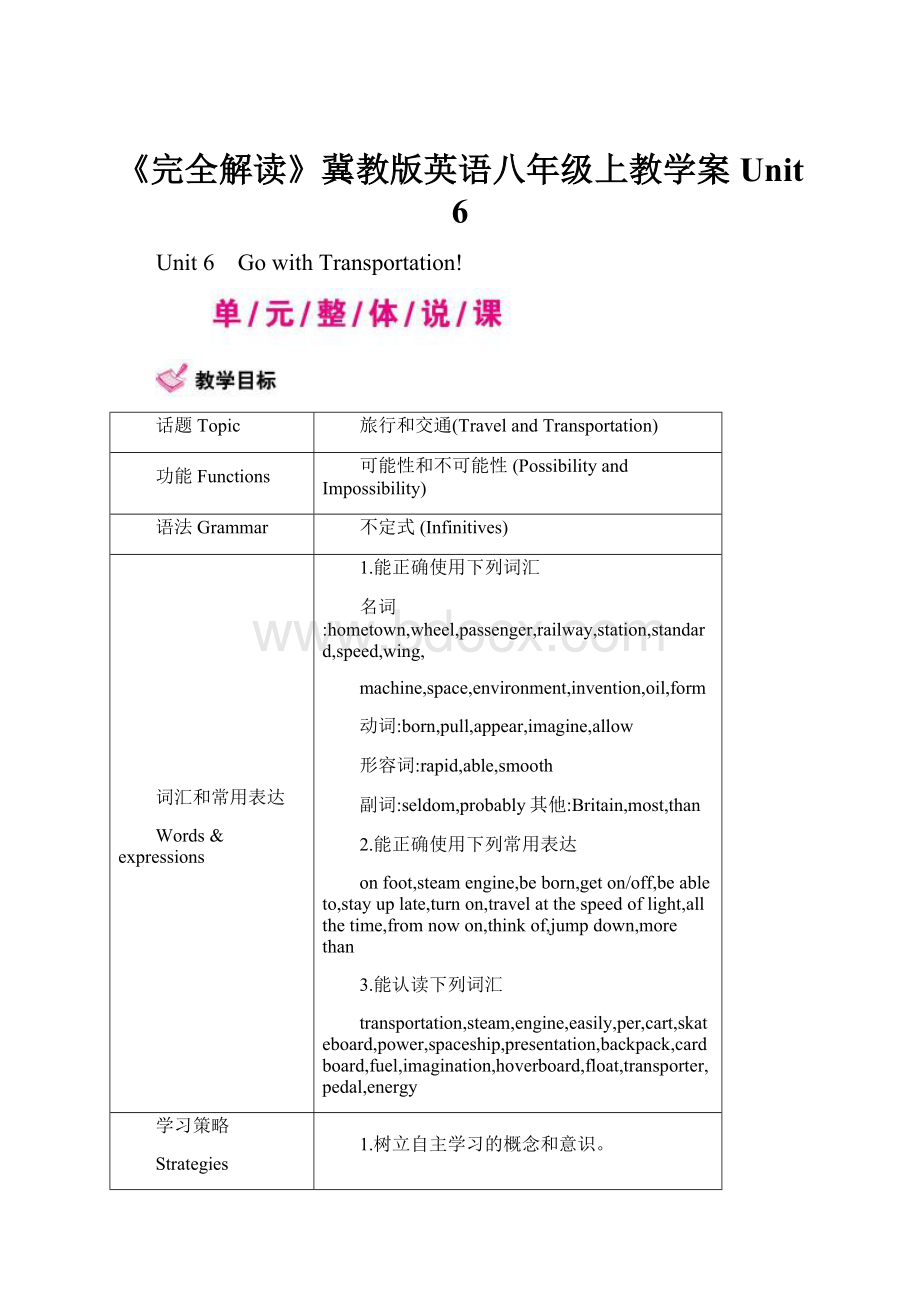《完全解读》冀教版英语八年级上教学案Unit6.docx
《《完全解读》冀教版英语八年级上教学案Unit6.docx》由会员分享,可在线阅读,更多相关《《完全解读》冀教版英语八年级上教学案Unit6.docx(83页珍藏版)》请在冰豆网上搜索。

《完全解读》冀教版英语八年级上教学案Unit6
Unit6 GowithTransportation!
话题Topic
旅行和交通(TravelandTransportation)
功能Functions
可能性和不可能性(PossibilityandImpossibility)
语法Grammar
不定式(Infinitives)
词汇和常用表达
Words&expressions
1.能正确使用下列词汇
名词:
hometown,wheel,passenger,railway,station,standard,speed,wing,
machine,space,environment,invention,oil,form
动词:
born,pull,appear,imagine,allow
形容词:
rapid,able,smooth
副词:
seldom,probably其他:
Britain,most,than
2.能正确使用下列常用表达
onfoot,steamengine,beborn,geton/off,beableto,stayuplate,turnon,travelatthespeedoflight,allthetime,fromnowon,thinkof,jumpdown,morethan
3.能认读下列词汇
transportation,steam,engine,easily,per,cart,skateboard,power,spaceship,presentation,backpack,cardboard,fuel,imagination,hoverboard,float,transporter,pedal,energy
学习策略
Strategies
1.树立自主学习的概念和意识。
2.总结所学语言材料中的语言规律并加以利用。
3.善于抓住用英语交际的机会。
文化知识Culture
1.了解并学习恰当使用英语表达有关交通的信息。
2.了解世界交通的发展历史和未来的交通方式。
三维目标
Three-dimensional
target
知识与
技能
1.能掌握以下单词:
hometown,Britain,seldom,rapid,wheel,born,passenger,
railway,most,station,standard,speed,wing,pull,able,appear,
machine,space,imagine,environment,invention,oil,probably,
smooth,allow,form,than
2.熟练掌握本单元短语:
onfoot,steamengine,beborn,geton/off,beableto,stayuplate,turnon,travelatthespeedoflight,allthetime,fromnowon,thinkof,jumpdown,morethan
3.能掌握以下句型:
Youcanwalktothebakerytobuydonuts.
Inthe1700s,manyscientistsworkedonsteamengines.
Maybetrainswillhavenowheelsinthefuture.
Thensteamwasabletopowerboatsandcars.
Lastnight,Dannystayeduplatetomakehisinvention.
Theteacheraskedustothinkaboutthefutureoftransportation.
Inthefuture,carswillprobablyusewaterorsunenergytopowerthem.
4.能了解动词不定式的用法。
三维目标
Three-dimensional
target
过程与
方法
1.学生通过思考、讨论、交流和合作等方式,了解课文内容,掌握知识要点,在教学过程中借助多媒体,提高效率。
2.能够通过师生说、生生说和自主听读来体验交际式英语教学的一般过程,掌握英语听说的基本方法。
3.能够通过小组口语交流,体验合作学习的过程和方法。
情感态度
与价值观
1.在学习中,敢于用英语来表达自己的看法。
2.培养学习英语的兴趣和学好英语的勇气。
3.乐于接触并了解异国文化。
概述
本单元围绕旅行和交通话题展开教学。
本单元讲述的是有关交通发展的历史事件和相关的故事。
在复习以前所学的有关交通词汇和短语的基础上,扩展一些新的词语和日常用语。
并通过谈论过去和现在的交通工具,引导学生产生联想,发挥想像力,培养学生的学习兴趣,学会表达“可能与不可能”的方法,学习动词不定式的用法。
第31课讲的是Danny,Brian和Jenny谈论各自喜欢的交通方式。
第32课通过图片讲述了火车的发展过程。
第33课谈论的是交通方式的进步。
第34课介绍Danny新发明的交通工具。
第35课描述出Sam喜欢的未来交通工具。
第36课为两封邮件,讲的是Brian和Jenny谈论各自身边发生的关于“未来的交通工具的发明”这一话题。
接下来是复习课,通过对本单元的词汇、语法、口语交际进行了复习。
教学
目标
1.能够掌握hometown,Britain,seldom,rapid,wheel等单词,学习onfoot,steamengine,beborn,geton/off,beableto,stayuplate等短语。
2.能够听懂有关旅行和交通方面的语句,识别主题,获取信息。
3.能够让学生理解和掌握动词不定式的用法。
1.运用单词,短语,句型等知识点,用英语描述交通运输方式的相关内容。
2.动词不定式的基本用法。
教学突破:
课前让学生通过与同学和老师交流或情景表演的方式了解更多旅行和交通的相关知识。
在有需要的时候,可以让学生在网上查阅信息,了解火车的发展史,以及新型的运输方式。
注意方法与价值观的培养:
采取自主学习与小组合作学习相结合,听说与读写相结合,任务型阅读
教学法与课件辅助等途径教学。
通过介绍自己的旅行方式来了解如何表示交通方式,以提高学生的语言表达能力。
使学生形成积极的情感态度,提高跨文化意识。
第一课时:
Lesson31
第二课时:
Lesson32
第三课时:
Lesson33
第四课时:
Lesson34
第五课时:
Lesson35
第六课时:
Lesson36
教学
目标
单词
卡片
名词:
hometown,wheel,passenger,railway,station,standard,speed,wing,machine,
space,environment,invention,oil,form,transportation,steam,engine,cart,
skateboard,spaceship,presentation,backpack,cardboard,fuel,imagination,
hoverboard,transporter,energy
动词:
born,pull,appear,imagine,allow,float
形容词:
rapid,able,smooth
副词:
seldom,probably,easily
介词&连词:
than
介词:
per
名词&动词:
power,pedal
其他:
Britain,most,Jeremy,Sam
教学
目标
短语
归纳
onfoot,steamengine,beborn,geton/off,beableto,stayuplate,turnon,travelatthespeedoflight,allthetime,fromnowon,thinkof,jumpdown,morethan
句型
集锦
1.Youcanwalktothebakerytobuydonuts.
2.Inthe1700s,manyscientistsworkedonsteamengines.
3.Maybetrainswillhavenowheelsinthefuture.
4.Thensteamwasabletopowerboatsandcars.
5.Lastnight,Dannystayeduplatetomakehisinvention.
6.Theteacheraskedustothinkaboutthefutureoftransportation.
7.Inthefuture,carswillprobablyusewaterorsunenergytopowerthem.
重点
语法
不定式(Infinitives)
TrafficintheCity
Withthedevelopmentofeconomy,trafficisbecomingoneofthegreatestproblemsofamoderncity.
Oneproblemispollution.Thewastegasesfromtheexhaustpipesaregreatenemiestotheair.Andtherearesomanycarsandbusesinthecitythattheharmtheycausetotheenvironmentisconsiderable.Anotherproblemiscrowdedness.Cityinhabitantsaresofamiliarwithtrafficjamsthattheyarepartoftheirlives.Timewaswastedontrafficandpeoplearemadeimpatientbytheawfultraffic.Worsethanthat,trafficaccidentsarereal-lifedisastersofbloodanddeath.Traffichasbecomeoneofthenightmaresofpeoplelivingincities.Tobuildhighwaysandbridgesonlyworksoutpartoftheproblem.Carsandbusesshouldbeimprovedtogiveofflesswastegases.Governmentshouldencouragecitizenstotakebusessothatthereislesstrafficontheroad.Peopleshouldobeytrafficrulesandtrynottomaketroubleontheroad.Cityareashouldbeexpandedsothatthereismorespaceforwideroads.Maybelow-pollutionhigh-efficiencymeansoftrafficshouldbeinvented.Onlyafterwepayenoughattentiontotheproblemwillitbepossibleforustosolveit.
第一课时 Lesson31:
HowDoYouTravel?
1.记忆单词hometown,Britain,seldom,rapid短语onfoot。
2.能够运用所学知识就喜欢的交通方式进行对话,训练学生听说读写的技能。
3.通过师生说、生生说和自主听读来体验交际式英语教学的一般过程,掌握英语听说的基本方法。
4.鼓励学生用英语表达自己的想法,表现自己,培养学生学好英语的信心以及小组合作意识。
1.掌握词汇hometown,Britain,seldom,rapid,接触词汇transportation,学习短语onfoot,ittakes…todo…,takeatrain/ship/bus/plane,byship/plane/bus,ridethetrain等。
2.复习常见交通工具的名称及交通方式的多种表达形式。
3.初步了解动词不定式的基本用法。
1.动词不定式的用法。
2.交通方式的多种表达形式。
3.谈论几种主要交通方式的优缺点。
本课的教学内容是第六单元的第一课时,主要内容涉及出行方式的介绍。
在授课之前先介绍几个与学生旅游相关的话题,进而引出交通方式的主题。
接着以典型图片展示的方式复习交通工具的名称及相关语言知识。
通过任务型教学,让学生读课文,帮助学生完成课文内容的学习。
课件PPT,录音机
StepⅠ.Leadin
Leadingin【情景1】
ShowpicturesofthetransportationonthePPT.
T:
What’syourfavouritetransportation?
T:
Howdoyoucometoschooleveryday?
S1:
Icometoschoolonfootbecausemyhomeisneartheschool.
S2:
IcometoschoolbybikebecauseIridemybikewell.
S3:
Icometoschoolbybusbecausemyhomeisfarawayfromschool.
T:
WhatdoyoutakeifyougoonatriptoBeijing?
S4:
Iloveridingontrainsbecausetheyarefast./Ilikeairplanesbecausetheyflyhighinthesky.
T:
What’syourfavouritetypeoftransportation?
Ss:
Bus./Car./Plane./Train./Bicycle./Ship.
[设计意图] 在复习以前所学的有关交通词汇和短语的基础上,扩展一些新的词语和日常用语。
Leadingin【情景2】
Talkaboutsomequestions.
What’stheweatherliketoday?
Doyouwanttotravelonsuchaday?
Howdoyouoftentraveloutside?
What’syourfavouritetypeoftransportation?
Askthestudentstodiscussthesequestionsforthreeminutes.Thenletthempresenttheanswersinclass.
[设计意图] 谈论与旅行相关的话题,进而引出交通方式的主题。
StepⅡ.Listening
1.T:
Listentothetapeandfillintheblankswiththewordsyouhear.
PPT
(1)Dannycan tothebakerytobuydonuts.
(2)Jennylikesto toothercities.
(3)Brianlikestravelling .
【Keys】
(1)walk
(2)takeatrain (3)byplane
2.T:
Let’sdoExercise2in“Let’sDoIt!
”.
ListentothepassageandfinishExercise2.
[设计意图] 提高学生听的技能,帮助学生初步了解课文内容。
StepⅢ.Reading
1.T:
Now,boysandgirls.Let’sreadthedialoguesilentlyandwriteTorF.CometoExercise1in“Let’sDoIt!
”.
2.PlaythetapeforLesson31athirdtime,andaskthestudentstolistenandreadaloudfollowingthetape.Remindthestudentstodotheirbesttoimitatethepronunciationtheyhear.
[设计意图] 使学生树立自信心,养成良好的阅读习惯并形成有效的学习策略。
3.Thefollowingsentencesshouldbeexplained.
☆教材解读☆
1.Icangoalmostanywhereonfoot.
◆此句中的anywhere用于肯定句,表示“任何地方”;anywhere可用于条件句、否定句或疑问句中,意为“什么地方”。
Icansleepanywhere.我哪里都能睡。
◆onfoot步行,是交通方式的一种,其中的介词需要用on,foot用其单数形式。
本短语是介词短语,在句中常作状语,有时可以与walk作谓语的句子进行同义句转换。
Igotoschoolonfoot.
=Iwalktoschool.我步行去上学。
2.Youcanwalktothebakerytobuydonuts.
句中的tobuydonuts是动词不定式短语,用在句中作状语,表示目的。
Mymotherwenttothemarkettobuysomefruits.我妈妈去市场买了一些水果。
3.Youcouldtakeashiptoyourhometown!
takeaship/byship意为“乘船”。
表示“乘坐某种交通工具”既可用“take+a/an+交通工具”,在句中作谓语,也可用“by+交通工具”,在句中作状语。
CanItakeatraintoBeijing,mom?
=CanIgotoBeijingbytrain,mom?
妈妈,我可以乘火车去北京吗?
4.Ofcourse,butitwouldtakealongtimetogofromCanadatoBritain.
Ittakes/tooksb.sometimetodosth.做某事花费了某人多长时间,It为形式主语,真正的主语是后面的不定式短语todosth.。
Ittakesme15minutestogotoschoolonfooteveryday.我每天步行15分钟去上学。
IttookmehalfanhourtodomyEnglishhomeworkyesterdayevening.昨天晚上我花了半个小时写英语作业。
5.Iseldomtravelbyship.
seldom是频度副词,意为“很少;罕见;难得”。
seldom通常放在实义动词之前,be动词、情态动词或助动词等之后,并且seldom一般不用于比较级和最高级。
seldomornever意为“很少,简直不”。
Iseldomeatbreakfast.我很少吃早餐。
Itseldomsnowsthere.那里很少下雪。
【拓展】 seldom虽表示不完全否定,但由于其含有否定的意义,故含有seldom的句子相当于否定句,在反意疑问句中,疑问部分要用肯定形式。
Youseldomcallonyourparents,doyou?
你很少去看望你的父母,对吗?
StepⅣ.Role-play
T:
NowIwilldivideyouintothreegroups.Eachgroupwilltakeonerole.Youmayuseyourimaginationtocreate.OK,let’spracticethedialogue.
[设计意图] 激发和培养学生学习英语的兴趣,发展学生自主学习的能力和合作精神。
StepⅤ.Practice
Ⅰ.用方框中所给词的适当形式填空
visit travel foot go take
1.Wegotoschoolon .
2.Itakeatrain myparentseverymonth.
3.Howabout shoppingwithme?
4.It metwohourstofinishtheworkyesterday.
5.Howdoyoulike ?
Ⅱ.用适当的介词填空
6.DannywillgobacktoCanada ship.
7.Londonis theocean.Howcanyougothere?
8.We’llsail Europenextweekandwillbebackinamonth.
9.Walkingismyfavouritekind transportation.
10.We’lltakeabus thebakery.
Ⅲ.句型转换
11.Thewomanwiththebabywalkedintotheshop.(对画线部分提问)
walkedintotheshop?
12.Heoftenhasbreadforbreakfast.(改为一般疑问句)
heoften breadforbreakfast?
13.Mr.Wilsongoestoworkbybuseveryday.(同义句转换)
Mr.Wilson workeveryday.
14.Igotoseemyunclebyboat.(对画线部分提问)
yougotoseeyouruncle?
15.Shelikesgoingtoschoolonfoot.(同义句转换)
Shelikes school.
【Keys】 Ⅰ.1.foot 2.tovi